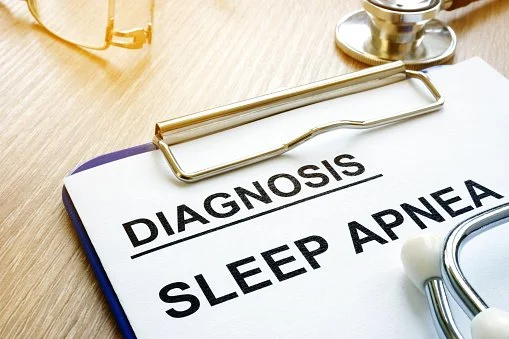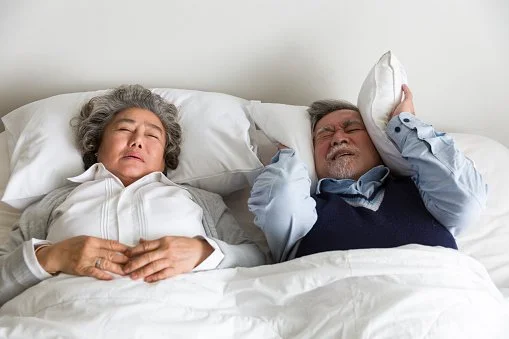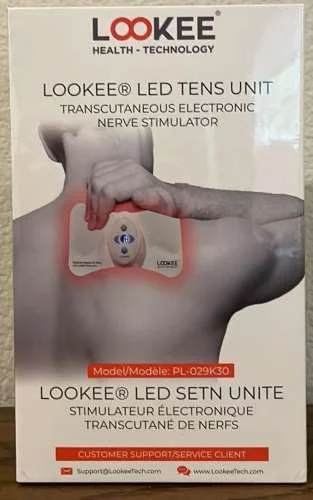Sleep Apnea, Snoring and the Vagus Nerve Connection
In order to keep this website up and running and financially sustainable, I have included affiliate links. If you click on one and make a purchase, I may earn a small commission which helps provide for further research for the A Carrot a Day website. A Carrot a Day will always choose products that I trust and love and can stand behind. A Carrot a Day will always choose ethics over money!! I truly appreciate each click!
What is Sleep Apnea
Sleep apnea is a sleep disorder that causes pauses in breathing or shallow breaths while you sleep. Breathing pauses can last from a few seconds to minutes. They may occur 5 to 30 times or more an hour. Typically, people with apnea don't realize they are pausing their breathing. Sleep apnea usually is a chronic (ongoing) condition that disrupts your sleep. When your breathing pauses or becomes shallow, you'll often move out of deep sleep and into a light sleep. As a result, your sleep quality is poor, making you tired during the day. Sleep apnea is defined as "an involuntary cessation of breathing during sleep, associated with irregularities of respiratory airflow of more than 10 seconds."
There are three types of sleep apnea: obstructive, central, and mixed. A blockage of the airway causes obstructive sleep apnea (the most common form of the disorder), usually when the soft tissue in the back of the throat collapses during sleep. Central sleep apnea occurs when the brain doesn't send proper signals to the muscles that control breathing. Mixed sleep apnea is a combination of both obstructive and central sleep apnea.
People with untreated sleep apnea are at higher risk for high blood pressure, heart attack, stroke, obesity, and diabetes. If you think you might have sleep apnea, see your healthcare professional. They will likely refer you to a sleep specialist for an overnight sleep study called polysomnography, which will diagnose whether you have sleep apnea and determine how severe it is.
Treatment options for sleep apnea may include lifestyle changes, such as losing weight and quitting smoking; exercises, mouth devices or mouthpieces that help keep your airway open; and continuous positive airway pressure (CPAP), which involves wearing a mask over your nose and mouth during sleep that delivers pressurized air to prevent your airway from collapsing. Surgery to remove excess tissue in the throat also may help some people with milder forms of this disorder. You can also check out Nightlase, which is a non-invasive laser treatment for sleep apnea and/or snoring, given at 21-day intervals. Usually, they give you 3-4 treatments and then recommend that you come back once a year. I am currently doing these treatments. Feel free to message me for details at admin@acarrotaday.com. I would be happy to talk to you about this option.
First, Determine If You Have Sleep Apnea and/or Snoring
One of the most common symptoms of sleep apnea is snoring. If you have sleep apnea, you may not be aware of it because it can occur during deep sleep. However, if your partner or roommate often complains about your snoring, it could indicate that you have sleep apnea. Other symptoms include daytime fatigue, waking up with a headache or dry mouth, and difficulty concentrating during the day.
I have a watch that reads my sleep apnea episodes, but it only gives me the data once I wake up in the morning. This helped me to see that I actually had sleep apnea, as my oxygen often dropped. One night my spo dropped to the low 70s and I got scared to go to sleep. Of course, you can’t live without sleep, so I went and googled for anything that might give an alarm when your oxygen gets low. I found one here, and now I can sleep in peace knowing that if my oxygen goes low I will get a vibration or alarm (depending on how you set it), and I can take some deep breaths, and get my breathing back on track. This has been a literal life-saver!
Causes of Sleep Apnea and Snoring
There are many different causes of sleep apnea and snoring. Some of the most common include being overweight, having an oversized tongue, enlarged adenoids or tonsils, excess mucus production, respiratory problems, allergies, sinus infections, dry air, smoking, and drinking alcohol.
CPAP for Sleep Apnea: What You Need to Know
Sleep apnea is a serious condition that can have long-term health consequences if left untreated. One of the most common and effective treatments for sleep apnea is continuous positive airway pressure (CPAP) therapy.
CPAP uses a device that delivers pressurized air through a mask worn over your nose and/or mouth while you sleep. The pressurized air helps keep your airways open so your breathing remains uninterrupted throughout the night. The device consists of three main components: a motor, a hose, and a mask. The motor creates pressurized air, which travels through the hose and into the mask, where you can inhale it.
Benefits of Using CPAP
The primary benefit of using CPAP is that it can help improve your sleep quality by increasing oxygen levels in your blood and reducing interruptions in your breathing at night. This means that you will wake up feeling refreshed and alert, leading to improved overall health and well-being during waking hours. CPAP may reduce or even eliminate snoring—often due to sleep apnea—and enable you to fall asleep faster and stay asleep throughout the night.
Choosing the Right CPAP Device
When selecting a CPAP device, there are several factors to consider, such as the size and noise level of the machine, type of mask (nasal or full face), comfort level while wearing the mask, portability, power source options (AC adapter or battery), ease of use, humidification settings (for added comfort), data tracking capabilities (to monitor usage) and cost. It’s essential to find one that best fits your needs, as some devices offer greater flexibility than others, depending on what type of user they’re designed for. Depending on the severity of your sleep apnea, you may require additional accessories such as heated tubing or different sizes/types of masks to get better results from using CPAP therapy.
While using a CPAP is one of the first lines of defense against sleep apnea, you might consider other ways to support your respiratory system.
How Do Mouth Guards Help?
Mouth guards keep your jaw in place, so your airway stays open throughout the night. This helps to reduce snoring and increases oxygen levels in the blood, which can improve symptoms associated with sleep apnea. When using a mouth guard for sleep apnea, it's essential to ensure that it fits properly and is comfortable enough to use every night while you're sleeping. It should also be easy to clean, so it doesn't become a breeding ground for bacteria and germs.
Wearing a mouth guard at night can protect your teeth from grinding during sleep—a condition known as bruxism—and relieve TMJ pain caused by clenching or grinding your teeth while asleep. So many benefits are associated with wearing a mouth guard when dealing with sleep apnea!
A TSD is designed to be worn inside your mouth while you sleep to hold your tongue in place. The device fits over the back of your teeth and has two arms that wrap around either side of your tongue. This keeps the tongue from falling back into the throat during sleep, which can block the airway and cause snoring or breathing pauses (apneas). The goal of using a TSD is to improve airflow during sleep and reduce or eliminate snoring and apneas.
Using a TSD may provide several benefits for people with sleep apnea. A tongue stabilizing device may effectively treat mild to moderate sleep apnea cases without resorting to more invasive treatments like CPAP machines or surgery. Some people may find that wearing a TSD is more comfortable than other treatments because they do not require any external equipment or tubes to be used while sleeping. Using a TSD may help improve sleep quality by reducing snoring and apneas.
Vagal Tone and Sleep Apnea
The vagus nerve is the longest nerve in the human body and plays a vital role in many involuntary functions, including heart rate, digestion, and respiration. A new study has found that the vagus nerve may also play a role in sleep apnea. The study conducted at the University of Pittsburgh found that people with sleep apnea were more likely to have a low vagal tone. The vagal tone is a measure of the activity of the vagus nerve. A low vagal tone has been linked to other health conditions, such as obesity, heart disease, and depression. The researchers believe that the vagus nerve may be a potential target for new treatments for sleep apnea.
One way to help manage sleep apnea is to strengthen the vagus nerve. The vagus nerve is responsible for controlling the muscles in the throat, and by strengthening it, you can help reduce the likelihood of the muscles collapsing and causing an obstruction. There are several ways to strengthen the vagus nerve, including exercises involving deep breathing, coughing, and electrical stimulation.
How to Exercise Your Vagus Nerve
Exercising your vagus nerve can help improve sleep apnea symptoms by helping reduce inflammation in your airways and increasing respiratory drive. Here are some simple exercises you can do at home to stimulate your vagus nerve:
Humming – Humming can help increase airflow through your nasal passages, which will help reduce inflammation in your airways and improve sleeping habits overall.
Gargling – Gargling with warm salt water helps stimulate the nerves around your throat, which can help increase airflow through your nasal passages and reduce inflammation in your airways.
Deep Breathing – Deep breathing exercises are a great way to relax and stimulate your vagal response, which can lead to improved respiration during sleep apnea episodes.
Yoga – Certain yoga poses like Ujjayi breath (breath of fire) or alternate nostril breathing will help stimulate both sides of your brain, leading to improved respiration during sleep apnea episodes and calming effects on both mind and body.
Massage – Massaging certain parts of your neck or back may help stimulate the nerves associated with respiration which could lead to improved respiration during sleep apnea episodes and relaxation throughout your entire body.
TENS Unit - A Transcutaneous Electrical Nerve Stimulation (TENS) unit may be just what you need. The vagus nerve is an integral part of your body’s autonomic nervous system and plays a vital role in activating the parasympathetic response of rest and relaxation. Unfortunately, this essential nerve can weaken due to prolonged stress or injury. Fortunately, using a TENS unit can help improve its functioning and restore balance to the body. (If you click on the link, make sure you put in the code word “carrots” for your discount)!
Strengthening Your Vagus Nerve with a TENS Unit
A TENS unit sends low-voltage electrical signals through the surface of your skin directly to the nerves under it. This creates a mild tingling sensation that helps relieve pain and increase blood flow in the area around your vagus nerve. Over time, this stimulation encourages your brain to produce higher levels of neurotransmitters like serotonin and dopamine, which are responsible for regulating moods. More elevated neurotransmitters help reduce stress hormones like cortisol, promoting relaxation and improving overall well-being.
Benefits of Using a TENS Unit
Using a TENS unit on areas around your vagus nerve has several benefits beyond just relieving pain or increasing blood flow. When used regularly, it can reduce inflammation and improve circulation throughout the body while boosting mental clarity and focus. It can also help with digestion issues such as bloating or constipation by stimulating the release of digestive enzymes from the pancreas, improving nutrient absorption in the gut. Finally, regular use of a TENS unit has been shown to boost energy levels and enhance sleep quality by decreasing nighttime cortisol levels and reducing anxiety symptoms associated with sleep apnea.
Can Diet Help with Sleep Apnea
It is well known that what we eat can impact our overall health, but did you know that diet can also play a role in sleep apnea? While there are many potential causes of sleep apnea, research has shown that diet can be a factor. Diets high in saturated fat and cholesterol have been linked to an increased risk of sleep apnea, while diets rich in omega 3, fruits, and vegetables may help to reduce the risk.
One of the most common triggers for sleep apnea is excess mucus production. Mucus is a sticky substance that helps to keep our airways moist and free from irritants. However, when there is too much mucus, it can block the airway and cause difficulty breathing. Reducing mucus-causing foods can help to ease symptoms and improve sleep quality. Common trigger foods include dairy products, sugar, alcohol, and caffeine. Avoiding these foods can help reduce mucus production and help you get a better night's sleep.
Mucus Causing Foods
While mucus is a necessary and essential part of our bodies, too much of it can be a problem, especially for those with sleep apnea. Mucus production is increased by eating foods high in histamine or containing histamine-releasing agents. Histamine is an inflammatory chemical released by the body in response to allergies or injury. Some common mucus-causing foods include dairy products, shellfish, eggs, nuts, and chocolate. Other potential triggers include alcohol and food additives like MSG. If you're producing too much mucus, avoid these triggers and eat more anti-inflammatory foods like fruits, vegetables, and omega-rich foods like flaxseeds. With a little effort, you can get your mucus production under control.
Mucus Fighting Foods
Most people don't realize that the foods they eat can significantly impact the mucus levels in their bodies. Certain foods can help to thin mucus, making it easier to expel from your body. For example, garlic and onions contain compounds that help break down mucus. Pineapple contains bromelain, an enzyme that helps break down mucus. And ginger has anti-inflammatory properties that can help reduce the swelling of the nasal passages. Other mucus-fighting foods include leafy greens, lemon juice, and hot peppers.
The warmth and steam in hot liquids such as tea or broth can help open your nasal passages and ease mucus production. Fluids help to prevent dehydration, which can also worsen mucus build-up. You can also add other ingredients like honey or lemon to boost the benefits.
The following herbs can help to reduce mucus build-up and make it easier to breathe:
• Fenugreek: Fenugreek is a common ingredient in Indian cuisine. It is also used in traditional medicine to treat various respiratory conditions, including bronchitis and asthma. Fenugreek seeds contain expectorant properties that help to loosen mucus and make coughing it up easier.
• Thyme: Thyme is another herb with expectorant properties. It can help to thin mucus, making it easier to expel from the body. In addition, thyme has antibacterial and antifungal properties that can help to fight infection.
• Peppermint: Peppermint is refreshing and invigorating. It also has potent decongestant properties that can help to clear nasal passages and relieve sinus congestion. Inhaling peppermint essential oil can also help reduce respiratory tract inflammation.
Another thing I recommend is an Air-Physio. It works by expelling the mucus from your lungs and is a great little lung exercise tool.
Aromatherapy
Aromatherapy may offer some help to those affected by sleep apnea.
Aromatherapy uses essential oils from plants to improve mood and health. The oils are usually inhaled or applied topically, though they can also be used in baths or diffusers. Essential oils have long been used as remedies for stress and anxiety, so it makes sense that aromatherapy might be a helpful tool for those struggling with sleep apnea.
How Aromatherapy Can Help With Sleep Apnea
Aromatherapy can help relax the soft tissue in your throat and open your airway, allowing you to breathe more easily while asleep. Essential oils like lavender, chamomile, eucalyptus, peppermint, rosemary, and ylang-ylang have all been shown to help reduce symptoms of OSA when inhaled regularly before bedtime.
For those suffering from obstructive sleep apnea (OSA), aromatherapy may provide some relief from the symptoms associated with the condition—but it’s important to consult with a healthcare professional before starting any new treatments involving essential oils. Essential oils like lavender, chamomile, and eucalyptus can help relax the soft tissue in your throat and open up your airways while sleeping—allowing you to breathe more easily while asleep—and possibly helping alleviate some of the disruptions caused by OSA throughout the night. If used correctly and safely under the guidance of an expert, aromatherapy could prove a valuable addition to any treatment plan for OSA sufferers looking for additional options for finding relief from their condition.
You can get a lot of great information on aromatherapy and useful essential oils here!
Can Humidifiers Help with Sleep Apnea
Humidifiers may work by adding moisture to the air in your bedroom. This helps to keep your nasal passages lubricated, which can make it easier to breathe while you sleep. Also, if you suffer from dry mouth or sore throat due to breathing through your mouth during sleep, humidity can help alleviate these symptoms as well.
Potential Benefits of Using a Humidifier
Using a humidifier may provide some relief from the symptoms of sleep apnea. Keeping your nasal passages lubricated and relieving dry mouth or throat soreness can help improve your overall quality of sleep. A humidifier may also reduce snoring by helping to keep your airways open while you rest.
Conclusion:
There are many ways to support people with sleep apnea. You can talk to your healthcare provider to see what works best for your situation. Feel free to try as many of these as you are comfortable with. No matter which remedies or means of support that you use, I do suggest using the Lookee spo bracelet or ring, to keep track of your progress.
Disclaimer: The contents of this website are based on personal experiences, opinions, and my own research. Information on this website is for educational purposes and is not meant to diagnose, replace, treat or cure any medical or mental health condition. Please see your doctor with any health-related questions. Statements on this website have not been approved or evaluated by the FDA. While perusing this site, please use your best judgment in conjunction with your Naturopath or other health care provider.











